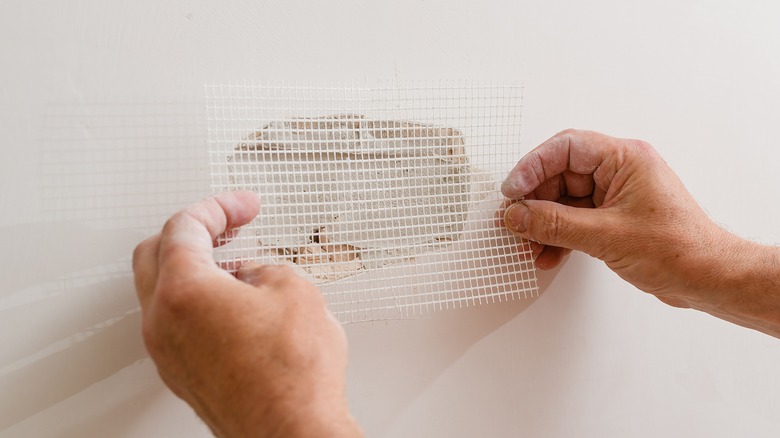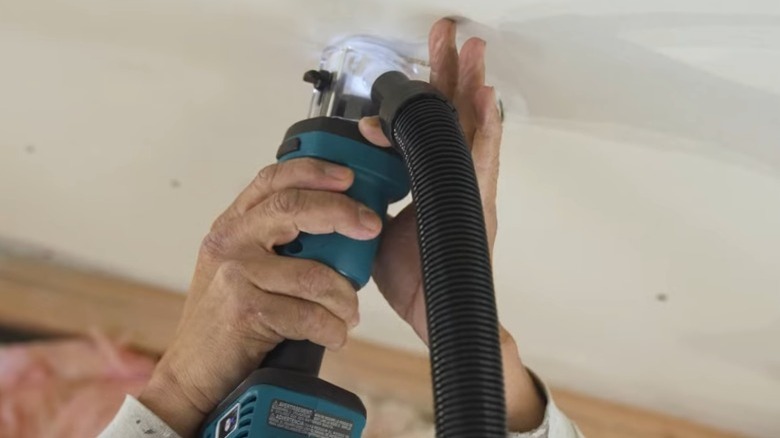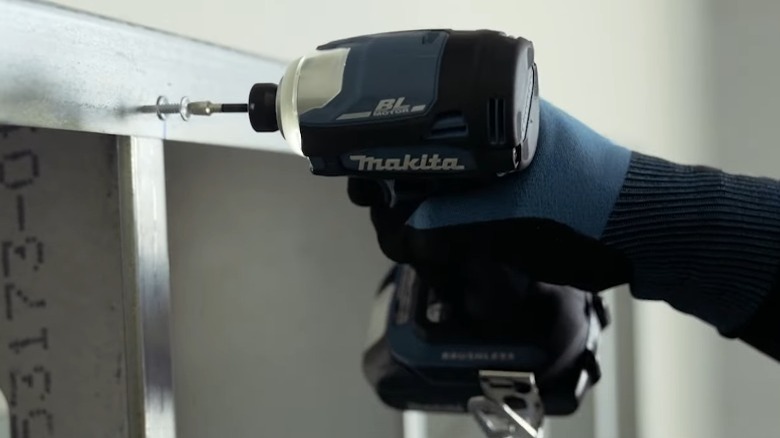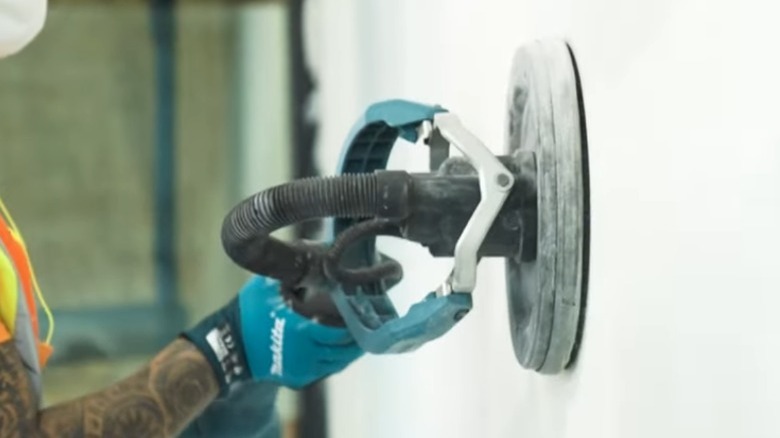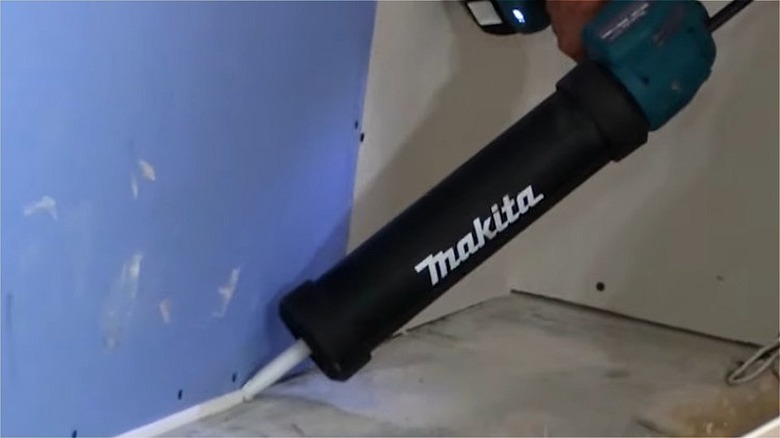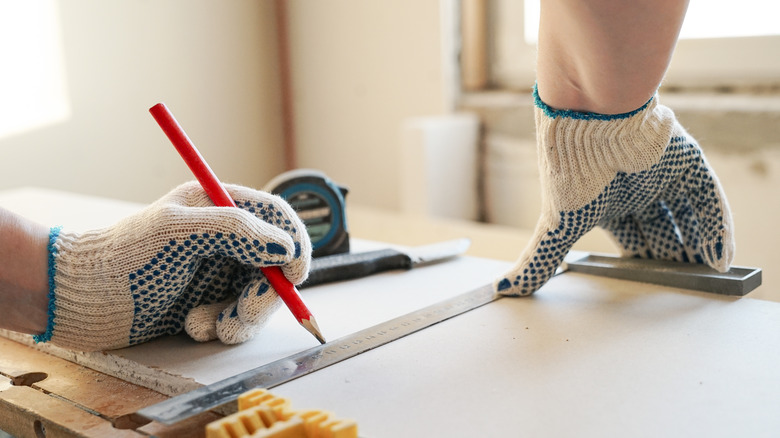5 Makita Tools You'll Want For Working On Drywall Repairs & Access Panels
We may receive a commission on purchases made from links.
Repairing drywall is never fun, but it's something that comes up fairly often. A doorknob could accidentally punch a hole in the wall, you might have water damage from a leaky roof, or you might simply need to access something on the other side, like the plumbing or electrical fixtures. You may even need to install something in the wall like an access panel. Of course, you could always pay someone to come and fix it, but odds are that this is something you'll have to deal with more than once. So it's worthwhile to invest in a few tools that you can use to quickly and easily take care of these problems yourself.
Like with any home improvement job, having the right tools makes all the difference, and Makita makes everything you need. Makita is widely considered to be one of the best power tool brands on the market. The company has been around since 1915, and has built its reputation on reliability and innovation, consistently bringing the newest technology and features to its tools so that they consistently remain on the cutting edge of the industry. Many of these product can be incredibly useful in tasks relating to drywall repair. I've had to cut and patch a few sections of drywall in my time and I've worked with similar versions of these tools. Here are the five Makita products you'll probably want to have the next time you need to repair drywall or install an access panel.
18V LXT Cordless Cut-Out Tool
You can fill many of the smaller holes in your drywall with spackle and call it a day, but anything larger than a quarter is going to need to be patched. There are mesh patches that you can use for some repairs, but large holes and water-damaged areas are going to need to be cut out and replaced with a new section of drywall. There are a few tools you can use for this. You can buy a simple jab saw if you want to save money with a cheaper hand tool for small repairs. An oscillating multi-tool works pretty well as well when you're cutting in a straight line, but the best thing for the job is a good rotary cut-out tool.
Makita sells a Cordless Cut Out Tool that is designed for the specific purpose of cutting and removing sections of damaged drywall. This is a rotary tool that uses a cutting bit to carve through sections of the wall. It's a little bit easier to line up than a multi-tool and it has the added benefit of being able to cut in any shape you want. This is handy if you ever need to cut out a rounded corner. It has a brushless motor that can deliver speeds up to 32,000 RPM while generating less heat. It takes both ⅛" and ¼" bits and can cut through two layers of drywall if needed. This was reviewed by Tool Box Buzz which stated that the tool "allows for a common frustrating cutting application on the job site to be done faster, cleaner, and easier."
18V LXT Compact Cordless ½ Hammer Driver/Drill
There are a few different methods for replacing sections of drywall. Once the old section is removed, you can attach a new section to a stud or joist if one is available. Otherwise, you will most likely need a small piece of wood to place behind the wall. This allows you to attach the new drywall to the old using screws. You will need a drill in either scenario both for drilling pilot holes and for driving the fasteners that will hold your newly cut piece of drywall in place.
Makita makes an 18V LXT Compact Cordless ½" Hammer Driver/Drill, which is more than sufficient for drywall repair. It has a brushless motor that can deliver up to 970 in. lbs. of torque. This power is controlled via a clutch which can help you quickly alternate between the force necessary to drill into the wood and the delicate touch that you need to perfectly drive screws so that they are flush without breaking the structural paper on the outside of the drywall. It also has two speeds which are controlled with a variable speed trigger and a compact, ergonomic design which makes it easy to handle while you're working on your wall.
Pro Tool Reviews called this a durable mid-level hammer drill that provides more than enough power for most use cases. While it isn't exactly construction grade, it should be plenty strong enough for any drywall-related projects and more besides.
18V LXT Brushless Cordless 9 Drywall Sander
After your new section of drywall is fixed in place and the spackle or joint compound you have used to fill the gaps is completely dry, you will need to sand the new surface before painting. For smaller jobs, you can do this easily enough with a simple piece of sandpaper or a random orbital sander. But for those who are replacing several large sheets of drywall, such as when a roof leaks and causes water damage all across your ceiling, you might want something with a bit more reach.
The Makita 18V LXT Brushless Cordless 9" Drywall Sander has an extendable pole that makes it easy to sand long seams on high walls and ceilings. This tool uses 9" hook-and-loop back sandpaper sheets that can make quick work of unsightly drywall seams. It also has a brushless motor and a built-in dust extractor that communicates with the tool via Bluetooth.
Stan Durlacher of Tool Box Buzz wrote a review of this product and gave it a 4.5 out of 5. He claimed that "the Makita XLS01Z Cordless Drywall Sander made for easy and effective finish sanding a much easier and a better work process for me. I would highly recommend this tool for anyone that does drywall finishing." The cost of the tool makes it a bit extravagant for minor repairs, but Durlacher argued that it's a good buy for people who are doing heavy amounts of drywall finishing.
18V LXT Compact Brushless Cordless Vacuum
Drywall dust is inevitable with all of the drilling and sanding you're going to be doing. This means you'll need a good shop vac to clean it all up. You might not want to cart around a giant one that you have to roll through the narrow hallways of your home on casters though. A compact, cordless unit makes cleanup much easier.
The Makita 18V LXT Compact Brushless Cordless Vacuum is an extendable cleaner that only weighs 3 lbs. This makes it easy to clean the walls and ceiling as well as the floors. It delivers up to 90 watts of suction power and gives you the option to use either a slide switch for continuous use or a trigger.
There haven't been many professional reviews of this vacuum, but YouTuber Deandra Aguilar did an extended review and said that the vacuum still worked like new after two years of daily use. She claimed that it wasn't overly loud and that the 2 Ah battery that comes in the kit lasts a really long time between charges. She said that hair can get stuck in it, so it's probably not ideal for heavy-duty use. That said, it should be more than sufficient for cleaning up drywall dust. Makita also makes a 40V version for those who are interested in getting a more powerful, general-purpose cordless vacuum.
18V LXT Cordless 29 oz. Calk and Adhesive Gun
You probably won't be using caulk for drywall installation or repair, but you will need a good caulk gun if you plan to install any access panels. That's because even though access panels are generally designed to fit into a precut hole, they are usually held in place with construction adhesive. This can be applied with a manual caulk gun if you're looking to save some money, but those willing to spend a bit more can get an electric one which makes the task considerably easier.
Makita makes a Cordless 29 oz. Caulk and Adhesive Gun which, like everything else on this list, is powered by its 18V LXT battery system. This can deliver up to 1,100 lbs of dispensing power and has five different dispensing speeds which are controlled by a dial to make it easy to get a nice consistent bead. It also has a rubberized soft grip handle and a built-in LED to help you see what you're gluing.
There haven't been many professional reviews of this tool, but it has a 4.7 out of 5 on Home Depot's website. Reviewers praised the for its ease of use and the consistent flow of pressure. The only criticisms were that it was a bit expensive and would therefore only be worthwhile for large jobs where you would get plenty of use out of it.
Our methodology
In order to make this list, I started by picking out the types of tools that I knew would be the most useful for repairing drywall and installing access panels from my own personal experience. I then looked through Makita's online catalog to see what options it had for these tools, examining them to see which of them had the specifications that would be needed for this type of job. Once I had the tools all picked out, I checked both professional and user reviews in order to make sure that the tools performed to their reported specifications.
